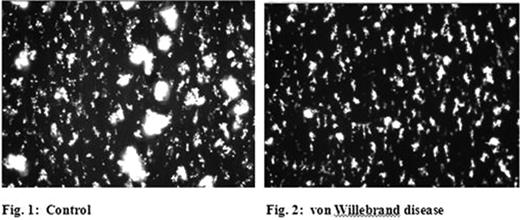Abstract
Abstract 3051
Poster Board II-1027
Von Willebrand disease (vWD) is one of the most common bleeding disorders worldwide, yet a precise approach to the diagnosis of this condition and prediction of its severity remains elusive. One important reason is that vWD is a blood flow-related disorder: a vW Factor-platelet GPIb binding defect in this condition exists under the high shear-rate conditions (>670 sec-1 in whole blood; >2000 sec-1 in PRP) of physiologic blood flow which exist in the arterioles of mucous membranes, from which most bleeding in vWD occurs. We therefore studied 15 children (ages 2-17, mean 9.9 yrs) and 2 adults with vWD, diagnosed according to the 2007 NHLBI clinical guidelines, and 12 healthy pediatric and adult controls. Blood was collected into a plastic tube containing 4 U/ml FC dalteparin, 1.75 μg/ml of the Tab (anti-CD41) monoclonal antibody directed against platelet GPIIb (courtesy of R. P. McEver), 1.0 μg/ml of an ALEXA 555-conjugated rabbit anti-mouse second antibody, and PBS (9 parts blood:1 part PBS). Within 30-90 min, the blood was then withdrawn at 667 and 1330 sec-1 through a special flow chamber allowing for blood exposure to 150 μm glass cover clips precoated with microfibrillar collagen (Helena Laboratories). Using epifluorescence digital videomicroscopy, we imaged platelets interacting in real time with the collagen substrate, and quantified with Simple PCI software the percent area (PA) covered by adherent platelet aggregates, the number of platelet aggregates (NA), and the total volume (TV) of these aggregates within a 435 μm x 580 μm field of view. Resolution was better than 1 μm.
Clinical bleeding score (ICTH) and ristocetin cofactor activity were also recorded. TV at 1330 sec-1 after 1 min, normalized to TV at 670 sec-1 after 1 min, to minimize patient/subject variation, was 2.65 ± 0.483 (mean ± SE) for normal subjects, but 1.55 ± 0.249 in vWD (P =0.043). The visualized pattern of platelet aggregation itself (Figs. 1 and 2, flow top-to-bottom) identified 14/16 patients, for whom aggregates were 19 μm in width or smaller but NA was 500-1000, and 6/7 controls, for whom aggregates were 32 μm in width or larger and NA was 300-600. This pattern is in accord with a greater accessibility of fresh platelets for the collagen surface in the presence of smaller aggregates, which “shield” neighboring surface sites less than do larger aggregates. Normalized TV, ristocetin cofactor activity, and bleeding score were not strongly correlated with one another, although bleeding score was positively correlated with age (P =0.0097). Platelet aggregate volume in vWD is markedly reduced in whole blood at a shear rate of 1330 sec-1, with a pattern of smaller but more numerous aggregates providing a high degree of sensitivity and specificity in the diagnosis of vWD.
No relevant conflicts of interest to declare.
Author notes
Asterisk with author names denotes non-ASH members.


This feature is available to Subscribers Only
Sign In or Create an Account Close Modal